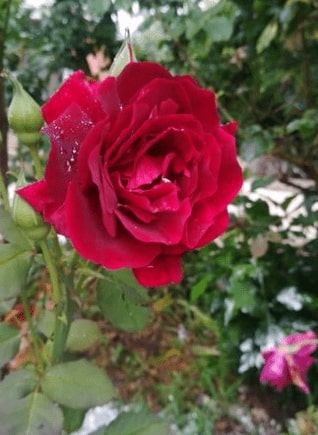Powdery Mildew Disease on Roses: Powdery mildew on roses is the most common disease that occurs on roses. This disease can be seen more in climates dominated by arid climates, but it is more common in regions with humid and temperate climatic conditions and in regions with high air temperature. It is more common in rose species with low strength and durability than in susceptible roses. The symptoms of powdery mildew on roses appear as blisters on the leaves of the rose and then expand on the young leaves, shrinking and deterioration occurs on the upper side of the leaf. The fungus covers the spores and mycelia in the form of white powder.
Young leaves, petals, stem and bud deterioration, top development and death of rose buds can be seen. Old leaves and stems on roses may not develop septoms. When the development period of roses begins in early spring, a favorable environment is created for the development of the disease. During this period, roses should be sprayed with fungicides at intervals of one week to ten days. This is how the protection of roses can be started. Wettable powder formations form a better coating on the surface of the roses. Sulfur is a protection measure for fungicide.
With rose pests Cultural Control
When the air temperature is more than 30 degrees Celsius, sulfur can have a caustic effect on rose leaves. If the disease on roses is highly severe, systemic and completely eradicating fungicides should be used in the advanced stage of the disease. Fungicides are most effective when fungal spores begin to develop. Fungicides are best used at the onset of the disease.
- Disease resistant rose species should be preferred.
- The remains of the diseased rose plant should be collected at the end of the season and absolutely destroyed.
- The rose plant should be planted in an area with good drainage, high organic matter and good sunlight, and the planting of the roses to be planted should not be done too often, rose plants should be planted with a certain planting intervals depending on the species.
- While watering rose plants, drip irrigation system should be preferred as irrigation technique.
When the rose leaves are wet or wet, it should not be worked between the plants, the rose plants should not be touched by hand, a soil test should be done when fertilizing roses, the irrigation period should be once a week during the dry season and the soil should be moist to a depth of 20-30 cm. When irrigation is to be done in roses, drip irrigation system should be realized. When the leaves of the roses will be watered, leaf irrigation should be carried out in the afternoon and evening.
Chemical pesticide use for rose disease; Chemical Control in Roses When chemical control is to be started in roses, the application should be made from April and should be carried out every 15-20 days within a certain program. Anvil – dinit5 – topas – benolex – sulfur – benlate – özyimi – fundazol – hegvistin – bavistin should be used.
Mildew Disease in Roses
This is a very common disease of roses in areas with humid, cloudy weather conditions. Wild roses and rose varieties are more susceptible to this disease. The symptoms of Mildy mildew disease in roses appear in the form of irregular shapes that turn from purple to red and brown on the leaves of young stems and flowers under cool and humid spring conditions. As the disease develops, the lesions on the leaves of roses fungalize as the disease progresses and develops. It is possible to see the white mycelium of the fungus angularly on the underside of the rose leaves. As the disease continues to develop on roses, yellow areas appear first. Later, these yellow areas turn into brown necrotic areas. It is very difficult to distinguish this disease from other diseases of roses. The symptoms are almost identical to other diseases of roses. Therefore, diagnosis is a very difficult process. This disease occurs in cloudy and humid weather conditions in summer. When the severity of this disease increases, it appears as irregular purple spots over large areas.
Rust Disease in Roses
Rust disease of roses is most often seen in severe outbreaks during the first growth period of roses at low temperatures and high humidity.

Where there are many rose leaves, the first symptoms of the disease are mostly found in the inner parts of the rose plant and close to the ground. The symptoms of rust disease on roses are seen as an orange or rust-colored pustular development on the underside of rose rust leaves. In this disease, rose leaves cannot perform their functions and their physiological balance is disrupted. Old leaves on roses show the symptoms of this disease earlier than young leaves. In the early spring season, it is in the form of spores that turn from light orange to yellow in the form of dust bubbles on the lower parts of rose leaves. At first, the spores are yellow, then turn orange or reddish during the summer season and brownish orange at the end of the autumn season.
Cultural control of rust disease in roses; 1- Resistant rose species should be preferred. 2- When the disease appears, the diseased leaves should be collected and destroyed immediately. 3- Ventilation of the plants should be done well. 4- Watering of rose plants should be done before noon. Excessive moisture formation on plants should be avoided. 5- Drip irrigation system should definitely be preferred as irrigation technique.
Chemical Solution to Rose Leaf Rust Disease; Chemical control of rust disease on roses should be started 25 days before the flower buds of roses show red tips. The second spraying should be repeated 15 days later. Spraying should be carried out 3-4 times a year. Fungicides named Bordeaux slurry, antracol, koruneb, enercol, superpon, safacol are used in the spraying process. What disease kills roses? How do you fix a diseased rose?
Root Cancer Disease in Roses

Root cancer disease in roses is the most serious disease that occurs in roses. It is quite common in every region with roses around the world. It is seen all over the world in roses grown in sandy – clay and clay soils and is a very common disease. Root cancer disease seen in roses manifests itself on the roots of roses, on the stem, where the rose branches are connected to the stem, in the form of crown-shaped round Welsh. These Walls have a regular, irregular, different shapes, mostly round, shapeless appearance and a hard outer surface. When we cut this diseased section on the roses and remove it from the plant, it is seen that the tissue of the rose plant is completely diseased and this formation in the plant is called a tumor. These Galler that occur on the rose plant prevent the exchange of water and nutrients from the roots to the stem or vice versa. As a result, it causes the rose plants to weaken and their height to remain stunted.
Fighting root cancer disease in rose plants
- Rose saplings should avoid heavy and moist soils.
- In grafted trees, the place of vaccination should be covered with putty.
- Cancerous saplings on roses should be destroyed.
- Care should be taken not to injure rose plants.
- The tools to be used when pruning roses should be disinfected regularly.
- Diseased plants on saplings should be uprooted and destroyed immediately. In addition, the soil in the area where the diseased rose is located should be removed if possible.
